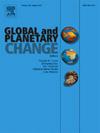Reduction in sediment yields from karst terrain in SW China over the past 600+ years
IF 4
1区 地球科学
Q1 GEOGRAPHY, PHYSICAL
引用次数: 0
Abstract
Previous studies have examined sediment yields and erosion in karst settings over recent decades, with little consideration of the evolution of rocky desertification over longer timescales. Here we reconstruct sediment yields from karst terrain in SW China over the past 600+ years by dating sediment deposition in a representative karst depression, and assess the contribution of historical sediment yields to rocky desertification. Results indicate that area-specific sediment yields (SSYs) during the early stage of sediment deposition (1368–1652) were the highest, triggered by deforestation and then cultivation associated with the first Hu-Guang Fills Sichuan migration during the Ming Dynasty. The relatively high SSYs during the middle stage (1653–1922) were related mainly to cultivation associated with the second Hu-Guang Fills Sichuan migration rather than deforestation, including the introduction of maize (Zea mays) and sweet potato (Ipomoea batatas) during the Qing Dynasty. SSYs increased again during the modern stage (1923–1962) due to massive deforestation at the end of the 1950s. During the latest stage (1963–2022), SSYs were the lowest as a result of increasing rocky desertification, reduced human disturbance, and the restoration of vegetation. The contributions of sediment yield to rocky desertification decreased across the middle, modern and latest stages, suggesting that the present-day rocky desertification was caused mainly by sediment yield stimulated by human activity over the past 500+ years before 1923, rather than over recent decades. Overall, our study provides more-comprehensive insights into the dynamics of rocky desertification over long timescales.
求助全文
约1分钟内获得全文
求助全文
来源期刊

Global and Planetary Change
地学天文-地球科学综合
CiteScore
7.40
自引率
10.30%
发文量
226
审稿时长
63 days
期刊介绍:
The objective of the journal Global and Planetary Change is to provide a multi-disciplinary overview of the processes taking place in the Earth System and involved in planetary change over time. The journal focuses on records of the past and current state of the earth system, and future scenarios , and their link to global environmental change. Regional or process-oriented studies are welcome if they discuss global implications. Topics include, but are not limited to, changes in the dynamics and composition of the atmosphere, oceans and cryosphere, as well as climate change, sea level variation, observations/modelling of Earth processes from deep to (near-)surface and their coupling, global ecology, biogeography and the resilience/thresholds in ecosystems.
Key criteria for the consideration of manuscripts are (a) the relevance for the global scientific community and/or (b) the wider implications for global scale problems, preferably combined with (c) having a significance beyond a single discipline. A clear focus on key processes associated with planetary scale change is strongly encouraged.
Manuscripts can be submitted as either research contributions or as a review article. Every effort should be made towards the presentation of research outcomes in an understandable way for a broad readership.
 求助内容:
求助内容: 应助结果提醒方式:
应助结果提醒方式:


